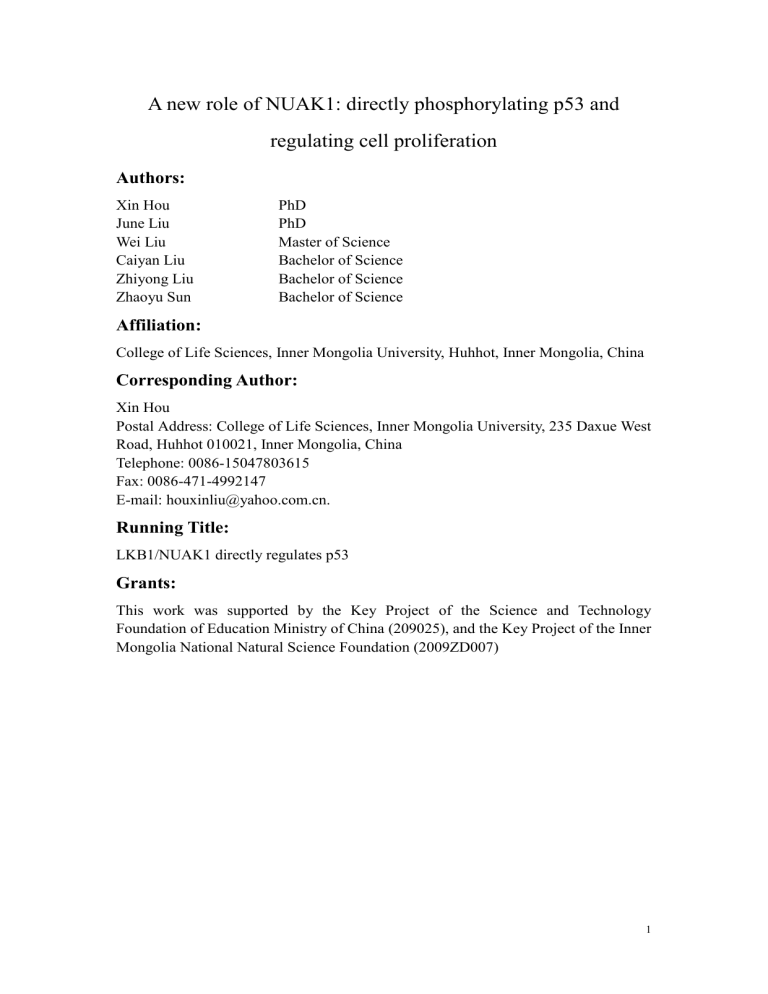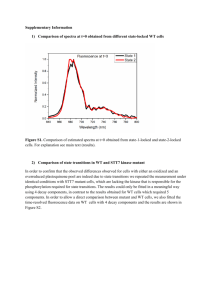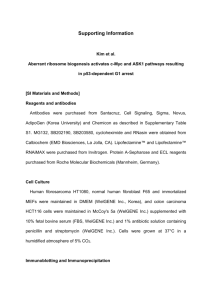Supplementary Information (doc 56K)

A new role of NUAK1: directly phosphorylating p53 and regulating cell proliferation
Authors:
Xin Hou PhD
June Liu PhD
Wei Liu Master of Science
Caiyan Liu Bachelor of Science
Zhiyong Liu Bachelor of Science
Zhaoyu Sun Bachelor of Science
Affiliation:
College of Life Sciences, Inner Mongolia University, Huhhot, Inner Mongolia, China
Corresponding Author:
Xin Hou
Postal Address: College of Life Sciences, Inner Mongolia University, 235 Daxue West
Road, Huhhot 010021, Inner Mongolia, China
Telephone: 0086-15047803615
Fax: 0086-471-4992147
E-mail: houxinliu@yahoo.com.cn.
Running Title:
LKB1/NUAK1 directly regulates p53
Grants:
This work was supported by the Key Project of the Science and Technology
Foundation of Education Ministry of China (209025), and the Key Project of the Inner
Mongolia National Natural Science Foundation (2009ZD007)
1
Supplementary Information (SI) Methods
Plasmids and constructs
Human LKB1 cDNA was amplified from human liver QUICK-Clone cDNA
(Clontech, Mountain View, CA, USA) and ligated into pcDNA4/myc-HisA
(Invitrogen, Carlsbad, CA, USA) to prepare pcDNA4-LKB1; pcDNA4-LKB1-KDM that contained kinase-deficient LKB1 was generated by site-directed substitution to
K78M and D176Y. Human NUAK1 cDNA was amplified from human brain
QUICK-Clone cDNA (Clontech) as previously described (Lizcano et al ., 2004), and was inserted into pMD19-T. Full-length NUAK1 cDNA was then subcloned and ligated into pcDNA3.1/V5-HisA (Invitrogen) to prepare pcDNA3.1-NUAK1. NUAK1 cDNA was also cloned into pET-32a+ to obtain pET-NUAK1. pET-NUAK1 (T221E), pET-NUAK1 (T221D), pcDNA3.1-NUAK1 (T211A), pcDNA3.1-NUAK1 (T211E), pcDNA3.1-NUAK1 (T211D) and pcDNA3.1-NUAK1 (K84A) were obtained by site-directed mutagenesis. Primers are listed in Table S1. pcDNA3-p53 was a gift from Dr. Jinghua Yan (Institute of Microbiology, Chinese Academy of Sciences,
Beijing, China), and pcDNA3-p53 (S15A) and pcDNA3-p53 (S392A) were generated by site-directed mutagenesis.
Purification of recombinant proteins with His tags
In a typical preparation, E. coli or HEK293T cells were harvested by centrifugation at
5000 g. The pellets were washed with cold PBS and resuspended in 50 ml buffer A
(50 mM NaH
2
PO
4
, 20 mM imidazole, 1 M NaCl, pH 7.4), and lysed by sonication.
After centrifugation at 13,000 g for 30 min, the supernatant that contained the soluble fraction was loaded onto a 5-ml Ni-NTA column (Pierce, Rockford, IL, USA) that had been equilibrated with buffer A. The column was washed with 25 ml buffer A that contained 40 mM imidazole and then with buffer A that contained 60 mM imidazole.
The proteins were eluted by an appropriate volume of buffer A that contained 200 mM imidazole, and identified by SDS-PAGE and western blotting with corresponding antibodies.
In vitro kinase assay
2
In vitro kinase assay of immunoprecipitates or recombinant NUAK1 and kinase-dead mutant K84A was performed in buffer that contained 8 mM MOPS–NaOH (pH 7.0),
0.01% Briji 35, 0.5 mM dithiothreitol, 10 mM Mg(CH
3
COO)
2
and 0.1 mM
[γ32
P]-ATP (300 cpm/pmol; Furi, Fuzhou, China); 100 μM SAMS peptide (Upstate
Biotechnology, Lake Placid, NY, USA) was added as substrate. After incubation for
10 min at 30°C with constant agitation, the reaction was stopped by adding 5 μl 3% phosphoric acid. A 20-μl aliquot was spotted onto a P81 paper square (Upstate
Biotechnology), allowed to dry, and then washed three times with 0.75% phosphoric acid and methanol. After transferring the paper square to a sealable plastic bag and adding 4 ml scintillation cocktail, radioactivity was measured in a scintillation counter
(MicroBeta 1450; PerkinElmer, Waltham, MA, USA). One Unit of activity was defined as 1 nmol peptide phosphorylated per minute. In vitro phosphorylation of
His-p53 by recombinant His-NUAK1 and mutants was also assayed. His-p53 (from
HEK293T cells) was mixed with His-NUAK1 (from HEK293T cells), K84A mutant,
T211A mutant, His-NUAK1 (from E. coli ), T211E mutant, T211D mutant, or
His-NUAK1 (from E. coli ) incubated with active-LKB1 (recombinant His-LKB1 from Sf21 cells provided as a complex with GST-STRADα and GST-MO25α; Upstate
Biotechnology) and isolated by Ni
2+
affinity chromatography, or with that deactivated by heating and isolated, incubated in 30 μl kinase buffer (50 mM Tris–HCl, pH 7.5,
0.1 mM Na
2
EDTA, 5 mM dithiothreitol, 2 mM MnCl
2
) and 0.1 mM [γ32 P] ATP (Furi) at 30°C for 30 min. The reaction was terminated with SDS-PAGE loading buffer.
Proteins were separated by SDS-PAGE, transferred onto a PVDF membrane, and detected by exposure to X-ray film for 8 h. After exposure, the PVDF membrane was analyzed by western blotting with anti-p53 polyclonal antibody.
3
Table S1 Primers used in this study.
Primer
Human LKB1 cloning
Human NUAK1 subcloning for pcDNA3.1-NUAK1
Human NUAK1 subcloning for pET-His-NUAK1
Quantitative RT-PCR of human p21/WAF1
ChIP quantitative PCR of p21/WAF1 promoter p53RE region
ChIP quantitative PCR of p21/WAF1
TATA-5’UTR region
Sequence
Forward: 5’-cggaattcatggaggtggtggaccccgc-3’
Reverse: 5’-ccgctcgagctgctgcttgcaggccgac-3’
Forward: 5’-cccaagcttatggaaggggccgccgcgc-3’
Reverse: 5’-cggaattcgttgagcttgctgcagatc3’
Forward: 5’-cggaattcatggaaggggccgccgcgc-3’
Reverse: 5’-cccaagcttgttgagcttgctgcagatc-3’
Forward: 5’-ctgtgatgcgctaatggcg-3’
Reverse: 5’-aagtcgaagttccatcgctca-3’
Forward: 5’-ggctggtggctattttgtcct-3’
Reverse: 5’-ccccttcctcacctgaaaaca-3’
Forward: 5’-agctgcgccagctgagg-3’
Reverse: 5’-gctccacaaggaactgacttcg-3’
4
Figure S1 Specificity of NUAK1 siRNA pool.
A549 cells were transfected with NUAK1 siRNA pool or with control siRNA. After
48 h cells were lysed and western blotting was performed with anti-NUAK1 antibody, anti-NUAK2 antibody, anti-AMPKα antibody, anti-LKB1 antibody and β-actin antibody.
Figure S2 In vitro kinase assay of His-NUAK1 and K84A mutant from HEK293T cells.
His-NUAK1 and K84A mutant were purified by Ni 2+ affinity chromatography. The in vitro kinase activity of recombinant proteins was assayed by measuring the 32 P labeling of SAMS peptide. One unit of activity was defined as 1 nmol SAMS peptide phosphorylated per minute.
Figure S3 Phosphorylation on five sites of p53 other than Ser15 and Ser392.
According to the manufacture’s instructions, COS cells were treated with 20μM methyl methanesulfonate (MMS) for 3h, and MCF-7 cells were treated with 100 μM etoposide for 4 h. The cells were lysed, and the lysate was subjected to SDS-PAGE followed by western blotting with phospho-p53 antibody sampler kit (Cell Signaling
Technology). According to the specificity information provided by the manufacturer
(http://www.cellsignal.com/products/9919.html), the phosphorylation of Ser6, Ser9,
Ser20 and Ser37 was checked in COS cells and that of Ser46 was checked in MCF-7 cells.
Figure S4 Cell cycle arrest observed in G361 cells.
G361 cells were stably transfected with vector control (Vec), kinase-deficient LKB1
(KDM), or wild-type LKB1 (+). Cells that stably expressed wild-type LKB1 were also transiently transfected with (+) or without (–) wild-type NUAK1, NUAK1 siRNA pool (siRNA), or control siRNA (Ctl-si). After synchronization, cells were treated with glucose deficient medium. Cells were then harvested, stained with propidium iodide, and analyzed by flow cytometry. Each analysis was carried out in
5
triplicate.
Figure S5 Cell-cycle arrest induced by NUAK1 requires p53.
A549 cells were transiently transfected with vector control (Vec), wild-type NUAK1
(NUAK1), NUAK1 T211E mutant (T211E), T211D mutant (T211D), K84A mutant
(K84A), T211E mutant and p53 siRNA pool (TE+si-p53), or T211D mutant and p53 siRNA pool (TD+si-p53). Cells were subjected to flow cytometry analysis as in
Figure S4.
Figure S6 Expression and phosphorylation of exogenous p53 in Hep3B cells . p53 null Hep3B cells were stably transfected with wild-type p53 (p53), p53 S15A mutant (S15A), p53 S392A mutant (S392A), or vector control (Vec). The cells were lysed, and the lysate was subjected to western blotting with anti-p53 antibody, phospho-p53 antibody sampler kit (Cell Signaling Technology) and β-actin antibody.
6








